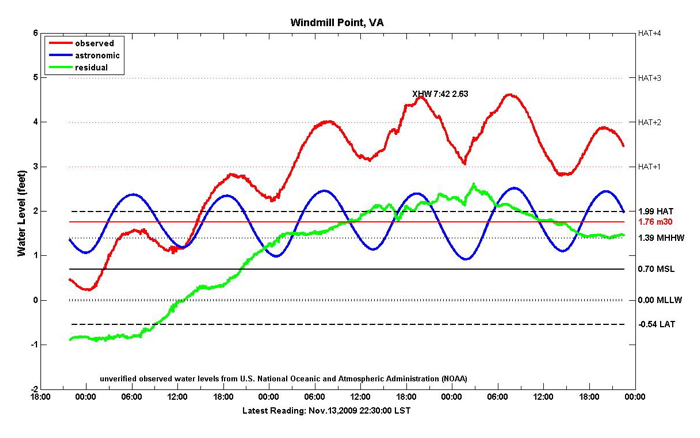How to read a Tidewatch Chart

Legend & Definitions
Red line = observed water level (unverified data from the U.S. National Oceanic and Atmospheric Administration)
Blue line = predicted astronomic tide
Green line = Residual difference between predicted and observed water level. Values are positive when observed values exceed predicted values, and negative when observed values fall below predicted values.
m30 is the 30-day mean water level covering the period of observation shown. It represents a time-local departure from MSL that is due to a combination of the seasonal tide, the decadal change in sea level, and the long-term sea-level trend relative to the land. The vertical reference for the astronomic tide is m30. For this chart, the m30 value is 1.76 feet above mean lower low water (MLLW), and 1.06 feet above mean sea level (MSL).
HAT is the elevation of Highest Astronomical Tide for the station shown. No predicted tide referenced to MSL or MLLW should ever be higher than HAT.
LAT is the elevation of Lowest Astronomical Tide for the station shown. No predicted tide referenced to MSL or MLLW should ever be lower than LAT.
MHHW, MSL, MLLW are the tidal datums of Mean Higher High Water, Mean Sea Level, and Mean Lower Low Water as defined by NOAA's National Ocean Service for the 1983-2001 National Tidal Datum Epoch (see http://tidesandcurrents.noaa.gov/).
Extratidal High Water (XHW) and Extratidal Low Water (XLW) are observed water-level extremes measured above the tidal datum HAT (XHW) or below the tidal datum LAT (XLW). These extremes occur only in the presence of a weather-induced residual water level or ‘storm surge’ (observed water level minus the astronomic tide), a sea-level anomaly (m30-MSL vertical difference) or, more often, a combination of the two. The astronomic tide—the water level change occurring at tidal frequencies—will not exceed either datum in the absence of a sea-level anomaly.
For a more detailed discussion, visit the Tidewatch Background page.
